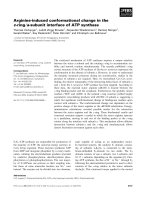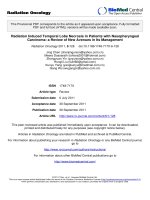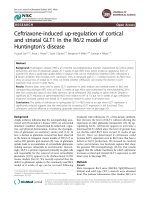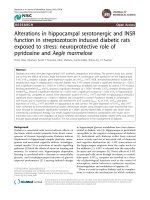Cinnamon attenuates neonatal Streptozotocin (NSTZ) induced pre-diabetic renal alterations in the SD rat model via maintenance of proper glucose homeostasis and antioxidant property
Bạn đang xem bản rút gọn của tài liệu. Xem và tải ngay bản đầy đủ của tài liệu tại đây (356.22 KB, 8 trang )
Int.J.Curr.Microbiol.App.Sci (2019) 8(1): 1047-1054
International Journal of Current Microbiology and Applied Sciences
ISSN: 2319-7706 Volume 8 Number 01 (2019)
Journal homepage:
Original Research Article
/>
Cinnamon Attenuates Neonatal Streptozotocin (nSTZ) Induced Pre-diabetic
Renal Alterations in the SD Rat Model via Maintenance of Proper Glucose
Homeostasis and Antioxidant Property
K. Siva Kesavarao1, T. Raghavarao2 and P. Suryanarayana1*
1
Lipid chemistry Division, National Institute of Nutrition, Hyderabad, Telangana, India
2
Andhra university, Biochemistry Division, Visakhapatnam, India
*Corresponding author
ABSTRACT
Keywords
Pre-diabetes,
Diabetic
nephropathy,
Cinnamon, STZ
Article Info
Accepted:
10 December 2018
Available Online:
10 January 2019
The major purpose of our study is to evaluate the impact of cinnamon on long term prediabetic induced renal alterations caused by intraperitonial induction of neonatal
streptozotocin (nSTZ). Two-day old male Sprague Dawley (SD) rat pups (n=30) received a
single intra peritoneal injection of STZ (90 mg/kg bw) dissolved in 0.1M citrate buffer, pH
4.5 while Control pups (n=8) received the vehicle alone. All rats were maintained on an
AIN-93G/M diet in individual cages and a subset of pre-diabetic animals received 3%
cinnamon in the AIN-93 diet. The majority of nSTZ rats exhibited impaired glucose
tolerance (IGT) (2h glucose>140mg/dl) or pre-diabetes by 2 months and the same was
maintained up to the 10 months as evidenced by OGTT as well as blood glucose levels.
Functional abnormalities of the kidney were studied by plasma as well as urinary
parameters. Renal pathological changes were observed by H&E staining and
immunoblotting was performed to determine the protein expressions of nephrin and
podocin. Urinary albumin, urea levels are elevated, whereas plasma albumin levels are
decreased in pre-diabetes rats compared to control rats. Protein and mRNA expression
levels of nephrin and podocin were lower in PD animals when compared to control.
Cinnamon cinnamon (CN) reduces urinary albumin levels, and also marginally prevented
the loss of protein and mRNA expressions of nephrin and podocin. Our findings might
provide a basis for long term pre-diabetes induced renal alterations ameliorated by
cinnamon, but the exact molecular mechanisms still require further elucidation.
Introduction
Diabetic nephropathy (DN) is slow and
progressive loss of kidney function over a
period of several years is another important
microvascular complication of diabetes and is
defined as glomerular filtration rate <60
mL/min/1.73 m2 for 3 months or more (Levey
and Mulrow, 2005). Diabetic nephropathy is
the primary cause of chronic kidney disease
(CKD) which is leading cause of renal failure,
also known as end-stage renal disease (ESRD)
(Fong et al., 2004; Mogensen, 1999;
Ruggenenti and Remuzzi, 1998), which impair
the quality of life and also increases morbidity
and mortality. In addition, treatment of CKD
1047
Int.J.Curr.Microbiol.App.Sci (2019) 8(1): 1047-1054
is involved with high cost throughout the
treatment period, especially when the person
enters to ESRD stage (Agarwal 2005; Ahlawat
et al., 2017). This leads to an increasing
financial burden on both individuals as well as
on health care systems.
The incidence/prevalence and progression of
DN may depend upon the type of diabetes,
severity of hyperglycemia and duration of
diabetes (Shahbazian and Rezaii, 2013;
Unnikrishnan et al., 2007). Around 20-30% of
both type-1 and type-2 diabetic subjects have
an evidence of diabetic nephropathy
(Shahbazian and Rezaii, 2013) and nearly
30% of chronic renal failures are due to
diabetic nephropathy in India (Agarwal and
Dash, 2000). According to the earlier Indian
studies,
the
prevalence
of
diabetic
nephropathy varied from 2.2% to 31%). The
progression of diabetic nephropathy to ESRD
is involved with several progressive steps
which
includes
hyperfiltration,
microalbuminuria
(early
nephropathy),
macroalbuminuria with decreased glomerular
filtration rate (GFR) (Palatini, 2012) followed
by the structural alterations like glomerular
basement
membrane
thickening,
and
glomerular sclerosis (Pourghasem et al.,
2015).
Cinnamon (CN) is derived from the inner bark
of Cinnamomum trees and has a long history
as a culinary and medicinal plant. There are
two primary varieties of CN, including
Cinnamomum cassia and Cinnamomum
zeylanicum. Cinnamomum zeylanicum is
known as the ‘true cinnamon’; it is lighter in
colour, sweeter and has a more delicate
flavour than Cinnamomum cassia, which has a
stronger taste and is darker. Short-term
ingestion of cinnamon on in vivo glucose
tolerance in healthy human volunteers has also
shown fasting glucose and two hour glucose
lowering effect (Solomon and Blannin, 2007).
In another study, Cinnamon ingestion reduced
the glucose response to OGTT in healthy
humans (Solomon and Blannin, 2009). In
addition, it also lowers the postprandial
glucose in healthy subjects (Hlebowicz et al.,
2007).
In addition to its hypoglycemic potentials CN
has also shown its beneficial effects in delay
of prevention of various complications. Earlier
our group demonstrated beneficial effects of
procyanidin-B2 enriched fraction of CN in
type-1 diabetes induced cataract and
nephropathy in rat model (Muthenna et al.,
2013; Muthenna et al., 2014). These beneficial
effects of procyanidin-B2 enriched CN
fraction is through its antiglycating potentials.
The other group has shown beneficial effect of
cinnamon oil on early stage diabetic
nephropathy against alloxan-induced renal
damage and its effect mainly through its
antioxidant and antidiabetic properties (Mishra
et al., 2010).
However, beneficial effects of cinnamon in
pre-diabetes induced renal complications are
not well studied. Hence the main purpose of
this study is to assess the beneficial effects of
CN in vivo against longterm pre-diabetes
induced renal abnormalities using nSTZ rat
model.
Results and Discussion
Effect of CN on plasma glucose and insulin
response during OGTT
Glucose response during OGTT two months
after STZ injection showed significant higher
plasma glucose levels at all time points, except
0 min, in untreated PD rats compared to those
of control rats indicating development of IGT
but not IFG (Fig. 1). Insulin levels were
significantly lower at 30 min after glucose
challenge (Fig. 1C) in untreated PD rats when
compared to control rats, but insulin levels at
0 and 120 min were similar between control
1048
Int.J.Curr.Microbiol.App.Sci (2019) 8(1): 1047-1054
and untreated PD rats. In addition, there was
no difference in HOMA-IR index between
untreated PD and control rats indicating that
nSTZ animals did not develop insulin
resistance. These findings are well correlated
with the previous experiment reported in
chaper-2 and also with our previous study
(Patil et al., 2014).
In addition to these observations, OGTT
graphs before termination or at ten months of
the experiment showed significant higher
plasma glucose levels at all time points in
untreated PD rats, compared to those of
control rats indicating these animals
maintained IGT and also developed IFG (Fig.
1). Whereas, insulin levels were significantly
lower at 30, 60 min after glucose challenge
(Fig. 1D) in untreated PD rats when compared
to control rats, but there is no difference in
insulin levels at 0 and 120 min between
control and untreated PD rats (Fig. 1D).
Together these OGTT glucose and insulin
responses indicated that nSTZ rats developed
of IGT by two months and its persistence for
at least 10 months. Moreover, CN-treated PD
rats exhibited significant hypoglycemic as the
2 hours glucose completely normalised and it
also improved insulin levels at 30 min and 120
min when compared to untreated PD rats (Fig.
1).
Clinical nephropathy parameters
were estimated and presented in Table 2.
Plasma urea, blood urea nitrogen (BUN) and
glomerular filtration rate (GFR) were
significantly higher in untreated PD rats when
compared to control rats. However, plasma
albumin significantly lower and creatinine
levels were marginally low in untreated PD
rats when compared the control rats indicating
altered renal function in PD rats. Feeding of
CN to PD rats has prevented renal
abnormalities by preventing altered albumin,
creatinine, urea, BUN and GFR (Table 2).
Kidney morphology by Haematoxylin and
Eosin (H&E)
In addition to the clinical parameters, we have
also studied morphology of kidney in control,
PD and PD+CN group rats by H&E. As
observed in the previous experiment, in this
study also there was a modest glomerular
lesion in untreated PD rat kidney sections
when compared to control rat kidney sections
indicating
development
of
structural
alterations in PD state. Feeding of CN to PD
rats prevent glomerular lesions compared to
untreated PD rats (Fig. 2). These protective
changes were similar as reported by the other
studies in alloxan or STZ induced kidney
damages or nephropathy in rats (Mishra et al.,
2010; Qusti et al., 2016)
Nephrin and podocin mRNA Expression in
kidney by qRT-PCR
Clinical parameters related to nephropathy
were estimated in urine and presented in Table
1. Urinary albumin, creatinine levels were
significantly higher and urinary urea levels
were marginally higher in untreated PD rats
than control rats indicating initiation of renal
abnormalities in PD rats. Interestingly, urinary
creatinine significantly lower and albumin, urea
and urine output were slightly low in the CNtreated PD rats than in untreated PD rats
indicating its protective role in PD induced
renal abnormalities (Table 1). Similarly,
Plasma parameters related to nephropathy
There was a marginal down regulation of
nephrin mRNA expression and significant
down regulation of podocin mRNA expression
was observed in untreated PD group compared
to the control group (Fig. 3) indicates the
development of nephropathy in the PD rats.
This data further supporting the clinical and
histological results. Feeding of CN to PD rats
significantly prevented down regulation of
nephrin and podocin mRNA expressions
compared to the PD rats (Fig. 3).
1049
Int.J.Curr.Microbiol.App.Sci (2019) 8(1): 1047-1054
Nephrin and podocin protein expressions
by Western blot
Oxidative stress and antioxidant enzyme in
the kidney
To further substantiate our qPCR results, we
have also used western blotting method to
study the expression of nephrin and podocin at
protein levels in the control, PD and CNtreated PD rat kidneys.
MDA levels were similar in all three groups,
but significantly enhanced the activity of SOD
in the untreated PD group as compared to that
of control group which indicates that longterm pre-diabetes also increases oxidative
stress (Table 3). CN-treated PD rats showed
SOD activity near to the controls when
compared to untreated PD rats, indicating that
CN prevented oxidative stress in the PD rat
kidney due to its antioxidant property (Table
3). Similar findings were reported in alloxan
or STZ induced oxidative stress in kidney in
rats (Mishra et al., 2010; Qusti et al., 2016).
As expected, the relative expression of
nephrin and podocin was slightly lower in
untreated PD rat kidneys than in the control rat
kidneys indicating development of renal
abnormalities. Feeding of CN to PD rats
marginally prevented loss of nephrin, but not
podocin protein when compared to untreated
PD rat kidneys (Fig. 4).
Table.1 Urinary nephropathy parameters
Parameters
Groups
Control
PD
20.73±1.26
42.46±4.90*
Albumin (mg/24 h)
12.43±1.16
17.33±1.65*
Creatinine (mg/24 h)
610±53
890±111
Urea (mg/24 h)
33.13±0.91
35.80±1.42
Water intake (mL/24 h)
8.40±1.20
13.60±1.72
Urine output (mL/24 h)
Values are mean ± SE, n=9-12 animals per group. *p<0.05 vs. Control,
p<0.05 was considered as statistically significant by ANOVA
PD+CN
33.06±3.10
11.56±1.08$
690±61
40.16±2.98
10.84±1.62
$
p<0.05 vs. PD.
Table.2 Plasma nephropathy parameters
Parameters
Groups
Control
PD
PD+CN
24.51±2.32
22.56±0.52*
24.37±0.95
Albumin (mg/dL)
0.65±0.03
0.63±0.03
0.64±0.02
Creatinine (mg/dL)
25.69±1.59
33.32±2.35*
34.56±1.83
Urea (mg/dL)
11.97±0.74
15.52±1.09*
16.11±0.85
BUN (mg/dL)
3.20±0.09
4.82±0.39*
3.12±0.41$
GFR/kg/bw
Values are mean ± SE, n=9-12 animals per group. *p<0.05 vs. Control; $p<0.05 vs. PD.
p<0.05 was considered as statistically significant by ANOVA. BUN, blood urea nitrogen;
GFR, glomerular filtration rate; bw, body weight
1050
Int.J.Curr.Microbiol.App.Sci (2019) 8(1): 1047-1054
Table.3 Malondialdehyde (MDA) and superoxide dismutase (SOD) activity in control, PD and
PD+CN group rat kidneys
Parameters
Groups
Control
PD
PD+CN
MDA (nmol/g kidney)
0.62±0.03
0.60±0.04
0.59±0.07
SOD (U/min/100 mg protein) 32.48±1.53
43.01±2.11*
34.21±2.26$
Lipid peroxidation [malondialdehyde (MDA)] was expressed as nmol/g kidney
and superoxide dismutase (SOD, enzyme) was expressed as Units/min/100 mg
proteins. Values are mean ± SE, n=6-9 animals per group. *p<0.05 vs. Control
and $p<0.05 vs. PD. p<0.05 was considered as statistically significant by ANOVA
Fig.1 Glucose (A and B) and insulin (C and D) responses at various time points (0, 30, 60 and
120 min) during OGTT on overnight-fasted rats. OGTT was conducted in control, PD and
PD+CN group rats after 2nd and 10th month of STZ injection. Values are mean ± SE, n=9–12
animals per group. *p<0.05 vs. Control; $p<0.05 vs. PD group. p<0.05 was considered as
statistically significant by independent-test and ANOVA. OGTT, Oral glucose tolerance test
Fig.2 Representative kidney sections of control, PD and PD+CN groups stained with
haematoxylin and eosin (H&E). The stained kidney sections were examined under a light
microscope and images were captured at a magnification of 400x
1051
Int.J.Curr.Microbiol.App.Sci (2019) 8(1): 1047-1054
Fig.3 Nephrin and podocin mRNA expression in rat kidneys from the control, PD and PD+CN
groups by qRT-PCR. Values are mean ± SE of three independent mRNA preparations for each
group. *p<0.05 vs. Control; $p<0.05 vs. PD. p<0.05 was considered as statistically significant by
ANOVA
Fig.4 Representative western blot (A) and densiometry (B) of nephrin and podocin protein
expression in the kidney of control, PD and PD+CN group rats. Equal protein loading was
confirmed with a β-actin antibody. The graphs represent comparative densities of each band
normalised to the corresponding level of β -actin. Values are mean ± SE of three independent
protein preparations for each group
In conclusion, our findings might provide a
basis for long term pre-diabetes induced
renal alterations attenuated by cinnamon due
to its hypoglycemic and antioxidant property,
but the exact molecular mechanisms still
require further elucidation.
1052
Int.J.Curr.Microbiol.App.Sci (2019) 8(1): 1047-1054
Acknowledgements
K.S.K. Rao received a research fellowship
from the Indian Council of Medical Research,
Government of India.
Funding sources
P.S.N. Received grants from the Department
of Biotechnology, Government of India
(Grant No: BT/PR3446/BRB/10/969/2011)
and National Institute of Nutrition (Indian
Council of Medical research, Government of
India) for intramural funding (#12-BS11).
Conflict of Interest: None declared.
References
Acharya, V.N. and K.P. Chawla (1978)
Diabetic nephropathy--a review. J
Postgrad Med, 24(3): 138-146.
Agarwal, S.K (2005) Chronic kidney disease
and its prevention in India. Kidney Int
Suppl, 98: 41-45.
Agarwal, S.K. and S.C. Dash (2000)
Spectrum of renal diseases in Indian
adults. J Assoc Physicians India, 48(6):
594-600.
Ahlawat, R., P. Tiwari and S. D'Cruz (2017)
Direct Cost for Treating Chronic
Kidney Disease at an Outpatient Setting
of a Tertiary Hospital: Evidence from a
Cross-Sectional Study. Value Health
Reg Issues, 12: 36-40.
Chugh, K.S., V. Sakhuja, H.S. Malhotra and
B.J. Pereira (1989) Changing trends in
acute renal failure in third-world
countries--Chandigarh study. Q J
Med, 73(272): 1117-1123.
Fong, D.S., L.P. Aiello, F.L. Ferris and R.
Klein (2004) Diabetic retinopathy.
Diabetes Care, 27(10): 2540–2553.
Hlebowicz, J., G. Darwiche and O. Björgell,
L.O. Almér (2007) Effect of cinnamon
on postprandial blood glucose, gastric
emptying, and satiety in healthy
subjects. Am J Clin Nutr, 85(6): 1552–
1556.
John, L., P.S. and Rao A.S. (1991) Prevalence
of diabetic nephropathy in non-insulin
dependent diabetics. Indian J Med
Res, 94: 24-29.
Levey, A.S. and C.D. Mulrow (2005) An
editorial update: what level of blood
pressure control in chronic kidney
disease? Ann Intern Med, 143(1): 7981.
Mishra, A., R. Bhatti, A. Singh and
M.P Singh Ishar (2010) Ameliorative
effect of the cinnamon oil from
Cinnamomum zeylanicum upon early
stage diabetic nephropathy. Planta
Med, 76(5): 412-417.
Mogensen, C.E (1999) Microalbuminuria,
blood pressure and diabetic renal
disease: origin and development of
ideas. Diabetologia, 42(3): 263-285.
Muthenna, P., G. Raghu, C. Akileshwari, S.N.
Sinha, P. Suryanarayana and G.B.
Reddy (2013) Inhibition of protein
glycation by procyanidin-B2 enriched
fraction of cinnamon: delay of diabetic
cataract in rats. IUBMB Life, 65(11):
941-950.
Muthenna, P., G. Raghu, P.A. Kumar,
M.V. Surekha and G.B. Reddy (2014)
Effect of cinnamon and its procyanidinB2 enriched fraction on diabetic
nephropathy in rats. Chem Biol Interact,
222: 68-76.
Palatini, P (2012) Glomerular hyperfiltration:
a marker of early renal damage in prediabetes and pre-hypertension. Nephrol
Dial Transplant, 27(5): 1708-1714.
Patil, M.A., P. Suryanarayana, P. Uday Kumar,
M. Srinivas and G.B. Reddy (2014)
Evaluation of Neonatal Streptozotocin
Induced Diabetic Rat Model for the
Development of Cataract. Oxidative
Medicine and Cellular Longevity, 2014:
1-10.
1053
Int.J.Curr.Microbiol.App.Sci (2019) 8(1): 1047-1054
Pourghasem, M., H. Shafi and Z. Babazadeh
(2015) Histological changes of kidney
in diabetic nephropathy. Caspian J
Intern Med, 6(3): 120-127.
Qusti, S., H.A. Rabey and S.A. Balashram
(2016)
The
Hypoglycemic
and
Antioxidant Activity of Cress Seed and
Cinnamon on Streptozotocin Induced
Diabetes in Male Rats. Evid Based
Complement Alternat Med, 2016: 1-15.
Rajapurkar, M.M., G.T. John, A.L. Kirpalani,
G. Abraham, S.K. Agarwal, A.F.
Almeida, S. Gang, A. Gupta, G. Modi,
D. Pahari, R. Pisharody, J. Prakash, A.
Raman, D.S. Rana, R.K. Sharma, R.N.
Sahoo, V. Sakhuja, R.R. Tatapudi and
V. Jha (2012) What do we know about
chronic kidney disease in India: first
report of the Indian CKD registry. BMC
Nephrol, 13: 1-8.
Ruggenenti, P.
and
G. Remuzzi (1998)
Nephropathy of type-2 diabetes
mellitus. J Am Soc Nephrol, 9: 2157-
2169.
Shahbazian, H. and I. Rezaii (2013) Diabetic
kidney disease; review of the current
knowledge. J Renal Inj Prev, 2(2): 7380.
Solomon, T.P and A.K. Blannin (2007)
Effects of short-term cinnamon
ingestion on in vivo glucose tolerance.
Diabetes Obes Metab, 9(6): 895-901.
Solomon, T.P and A.K. Blannin (2009)
Changes in glucose tolerance and
insulin sensitivity following 2 weeks of
daily cinnamon ingestion in healthy
humans. Eur J Appl Physiol, 105(6):
969-976.
Unnikrishnan, R.I., M. Rema, R. Pradeepa,
M. Deepa, C.S. Shanthirani, R. Deepa
and V. Mohan (2007) Prevalence and
risk factors of diabetic nephropathy in
an urban South Indian population: the
Chennai Urban Rural Epidemiology
Study (CURES 45). Diabetes Care,
30(8): 2019-2024.
How to cite this article:
Siva Kesavarao, K., T. Raghavarao and Suryanarayana, P. 2019. Cinnamon Attenuates
Neonatal Streptozotocin (nSTZ) Induced Pre-diabetic Renal Alterations in the SD Rat Model
via Maintenance of Proper Glucose Homeostasis and Antioxidant Property.
Int.J.Curr.Microbiol.App.Sci. 8(01): 1047-1054. doi: />
1054









